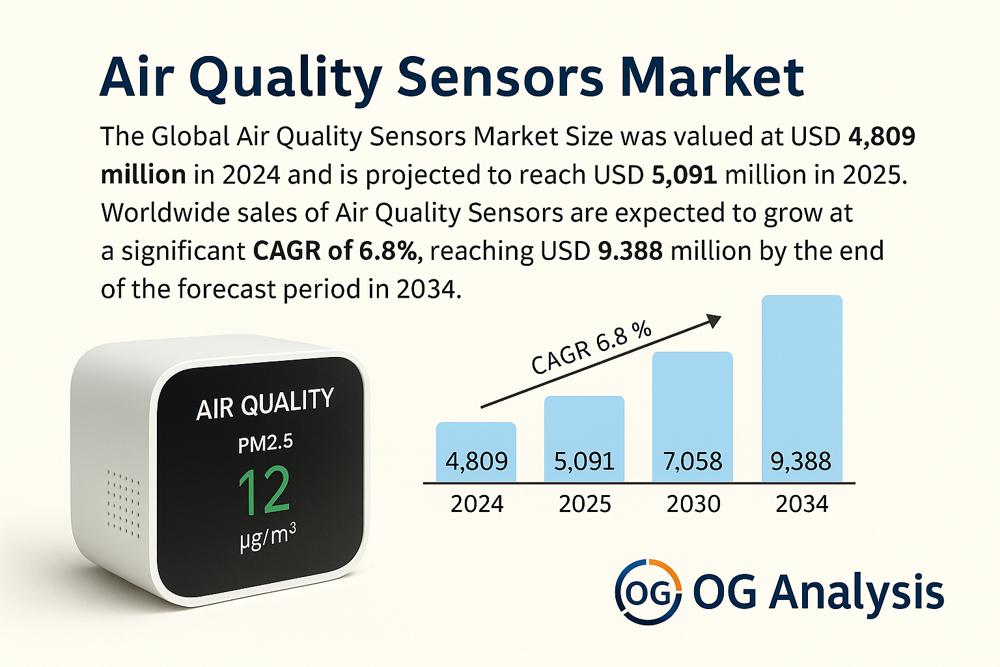breathing Better: How Air Quality Sensors Are Revolutionizing Environmental Monitoring
As climate change, urbanization, and health awareness converge, air quality monitoring has become a critical public and private sector priority. The Global Air Quality Sensors Market was valued at USD 4,809 million in 2024 and is expected to grow to USD 5,091 million in 2025, with projections soaring to USD 9,388 million by 2034, at a CAGR of 6.8%.
This surge is not just about technology—it’s about changing lifestyles, regulatory mandates, and public health resilience. Backed by global leaders like Honeywell, Siemens, TE Connectivity, Emerson, and Bosch, the market is seeing rapid innovation in sensor accuracy, smart integration, and data visualization platforms.
1. Are Air Quality Sensors Becoming the New Norm in Smart Homes and Cities?
Yes—air quality sensors are no longer niche tools. Integrated into smart thermostats, home assistants, and public transport hubs, these sensors are the backbone of urban health infrastructure. In smart cities, real-time air monitoring is being linked to traffic management systems and green space planning. For homeowners, affordable indoor sensors offer insights into CO₂, PM2.5, VOCs, and allergens, enhancing daily comfort and safety.
2. How Are Industrial Users Leveraging Real-Time Air Monitoring for Compliance and Efficiency?
In the industrial sector, air quality sensors are becoming essential for occupational safety and regulatory compliance. Real-time monitoring helps detect hazardous gases, enabling immediate mitigation and preventing costly shutdowns. Companies like Emerson and TE Connectivity are equipping manufacturing plants, chemical facilities, and mining operations with networked sensor arrays that feed directly into compliance dashboards and predictive maintenance tools.

3. What’s Driving the Shift Toward Indoor Air Quality (IAQ) Awareness Post-Pandemic?
Post-COVID, the world woke up to the invisible threat of indoor air pollutants. From residential homes to corporate offices, demand for compact, connected indoor sensors has surged. Air quality now influences real estate value, employee wellness, and even school safety protocols. Brands like Bosch Sensortec and Alphasense are capitalizing on this by offering low-power, IoT-enabled IAQ sensors that deliver air scoring straight to your smartphone.
Click Here for the Full Market Report:
4. Which Regions Are Leading the Way in Sensor Adoption—And Why?
Asia-Pacific is currently the most aggressive growth region, driven by air pollution crises in China and India, smart city initiatives, and industrial expansion. Europe leads in regulatory frameworks (like the EU’s Ambient Air Quality Directives), while North America is seeing growth from consumer adoption and workplace safety laws. Even Latin America and the Middle East & Africa are emerging due to increased environmental awareness and government-led air quality programs.
5. Are Sensor Innovations Keeping Pace with Emerging Pollutant Detection Needs?
Absolutely. The next wave of sensors isn’t just detecting PM and NOx—they’re being tuned to measure ammonia, ozone, carbon monoxide, and even viral particles in some advanced models. Companies like Thermo Fisher Scientific and Agilent Technologies are pushing the boundaries with multi-pollutant sensors, AI calibration models, and modular architecture for custom applications. Innovation is also focused on miniaturization and energy efficiency, making deployment easier across rural and urban settings alike.
6. How Are Governments and Environmental Agencies Using This Data for Policy and Planning?
Governments are leveraging air quality sensor data for real-time public alerts, urban planning, emissions regulation, and climate change reporting. In the government segment, both indoor and outdoor monitoring stations are being expanded. Tools like interactive pollution maps, heat sensors, and automated threshold-based alarms are being fed into centralized platforms to support evidence-based policymaking.
7. What Role Will AI and Cloud Connectivity Play in the Next Decade of Sensor Deployment?
The future of air quality sensing lies in cloud-based platforms, AI analytics, and predictive insights. Companies like Horiba Ltd. and RAE Systems are integrating sensors with machine learning to forecast pollution spikes, recommend mitigation actions, and support remote diagnostics. Cloud ecosystems allow users—from city planners to homeowners—to access, compare, and share air quality data in real time, enhancing collaboration across industries and geographies.
Click Here for the Full Market Report:
Market Segmentation Snapshot: Key Categories and Regional Insights:
By Type:
-
Indoor
-
Outdoor
By Pollutant:
-
Particulate Matter
-
Gases
-
Others
By End User:
-
Residential
-
Commercial
-
Industrial
-
Government
By Region:
-
North America
-
Europe
-
Asia-Pacific
-
Latin America
-
Middle East & Africa
Explore More Industry Insights:
|
Global 4K TV Market Outlook Report: Latest Trends and Growth Opportunities by Region
|
Connect with us on:
Phone: +91 888 64 99099
Email: mailto:sales@oganalysis.com
Learn More about OG Analysis
OG Analysis, established in 2009 has 14+ years of experience and served 1800+ clients from 980+ companies operating in 54+ countries. OG Analysis is a leading provider of market research reports in Chemicals, Energy, Oil & Gas, Food & Beverage, Electronics & Semiconductors, Automotive, Telecommunication, Healthcare and Other industries.
